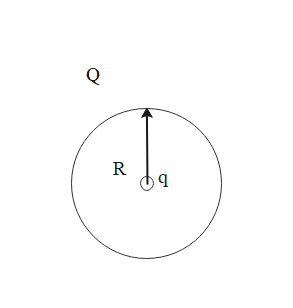Question
Question: Charge Q of mass m revolves around a point charge q due to electrostatic attraction. Show that its p...
Charge Q of mass m revolves around a point charge q due to electrostatic attraction. Show that its period of revolution is given by T2=Qq16π3ε0mR3

Solution
As the charge Q of mass m is revolving in a circular motion, it experiences centripetal force. Next, find the electrostatic force between the two particles. As these are the only two forces, they must be equal as energy is always conserved. So, equate and substitute them accordingly.
Formula used:
T=v2πr⇒F=Kr2q1q2
Complete step by step answer:
The mass m of charge Q is moving in a circular way around the point mass. Therefore, it has some centripetal force acting towards the centre.
Next, the two charged particles experience some electrostatic force of attraction between them. As energy is conserved and these are the two forces acting in the overall system, they must be equal.
The centripetal force acted is
F=Rmv2
The electrostatic force of attraction will be,
F=Kr2q1q2
As these two forces are equal,
rmv2=Kr2q1q2⇒v=mrKq1q2
Also, the time period formula can be written as,
T=v2π⇒T=2πKq1q2m×r∴T2=Qq16π3ε0mR3
Therefore, we can derive the time period formula in this way.
Additional information:
The force that is necessary to keep an object moving in a curved path and that is directed inward toward the centre of rotation is known as the centripetal force. The difference between centripetal and centrifugal force has to do with different 'frames of reference,' that is, different viewpoints from which you measure something. With a rocket, though, its mass changes drastically, while the force, in this case the thrust of the rocket motors, remains nearly constant. This causes the acceleration toward the end of the boost phase to increase to several times that of normal gravity. Under the normal force of gravity, thermal motion causes continuous mixing which prevents blood cells from settling out of a whole blood sample. However, a typical centrifuge can achieve accelerations that are 600 to 2,000 times that of normal gravity. This forces the heavy red blood cells to settle at the bottom and stratifies the various components of the solution into layers according to their density.
Note:
There’s a lot of difference between the centripetal force and the centrifugal force. Centripetal force is usually real force but the centrifugal force is an apparent force. The difference between the centripetal and centrifugal force is the frame of reference.
